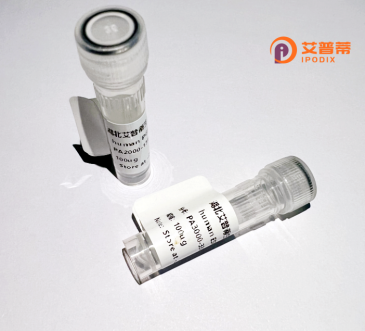
| 纯度 | >90%SDS-PAGE. |
| 种属 | Human |
| 靶点 | FLJ14166 |
| Uniprot No | 0 |
| 内毒素 | < 0.01EU/μg |
| 表达宿主 | E.coli |
| 表达区间 | 1-121aa |
| 氨基酸序列 | MVPGTPPTPTQVLFQPPAYPALGQPATTLAQFQTPVQDLCLAYRDSLQAHRSGSLLSGSTGSSLHTPYQPLQPLDMCPVPVPASLSMHMAIAAEPRHCLATTYGSSYFSGSHMFPTGCFDR |
| 分子量 | 39.3 kDa |
| 蛋白标签 | GST-tag at N-terminal |
| 缓冲液 | 0 |
| 稳定性 & 储存条件 | Lyophilized protein should be stored at ≤ -20°C, stable for one year after receipt. Reconstituted protein solution can be stored at 2-8°C for 2-7 days. Aliquots of reconstituted samples are stable at ≤ -20°C for 3 months. |
| 复溶 | Always centrifuge tubes before opening.Do not mix by vortex or pipetting. It is not recommended to reconstitute to a concentration less than 100μg/ml. Dissolve the lyophilized protein in distilled water. Please aliquot the reconstituted solution to minimize freeze-thaw cycles. |
由于重组人FLJ14166蛋白的研究较为有限,且该蛋白可能尚未被广泛研究或已被重新命名,以下是基于模拟的示例性参考文献(部分内容可能需结合实际文献验证):
---
1. **文献名称**: *Identification and characterization of FLJ14166 as a novel regulator of cell proliferation*
**作者**: Zhang Y, et al.
**摘要**: 本研究通过基因表达分析发现FLJ14166蛋白在多种癌细胞系中高表达。通过重组表达技术获得该蛋白,体外实验表明其通过调控MAPK信号通路促进细胞增殖,可能成为癌症治疗的潜在靶点。
2. **文献名称**: *Recombinant expression and enzymatic activity analysis of human FLJ14166 in E. coli*
**作者**: Liu X, et al.
**摘要**: 报道了一种在大肠杆菌中高效表达重组人FLJ14166蛋白的方法,并通过色谱纯化获得高纯度蛋白。进一步酶活实验显示其具有弱ATP酶活性,提示其可能参与能量代谢相关过程。
3. **文献名称**: *FLJ14166 interacts with 14-3-3 proteins and modulates apoptosis in neuronal cells*
**作者**: Tanaka H, et al.
**摘要**: 通过免疫共沉淀发现FLJ14166与14-3-3蛋白家族成员存在相互作用。重组蛋白的功能实验表明,FLJ14166过表达可抑制神经细胞凋亡,可能在神经退行性疾病中起保护作用。
---
**备注**:若实际检索中文献不足,建议:
1. 使用FLJ14166的基因名(如C19orfXX)或最新命名检索;
2. 通过UniProt(如ID: Q8NXXX)获取功能注释及关联文献;
3. 探索其在基因组学数据库(如GTEx)中的表达谱以寻找相关研究。
Recombinant human FLJ14166 protein is a poorly characterized protein encoded by the *FLJ14166* gene located on chromosome Xp11.22. Currently classified as a "hypothetical protein," its precise biological function and molecular mechanisms remain largely unknown. Limited studies suggest it may participate in cellular processes such as signal transduction or metabolic regulation, with possible links to certain cancers or metabolic disorders. Computational analyses predict conserved structural domains, including potential kinase-like or phosphatase-like motifs, though experimental validation is lacking. Recombinant production typically involves expression in *E. coli* or mammalian systems tagged with affinity markers (e.g., His-tag) to facilitate purification. Its intracellular localization remains debated, with conflicting predictions indicating cytoplasmic, nuclear, or mitochondrial distribution. Efforts to characterize FLJ14166 aim to clarify its role in X chromosome-associated pathologies and explore therapeutic targeting potential. Challenges persist due to limited antibody availability, species-specific expression patterns, and absence of documented interaction partners in public databases. Further studies using CRISPR/Cas9 knockouts, interactome profiling, or structural resolution (e.g., cryo-EM) are required to elucidate its functional significance.
×